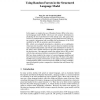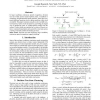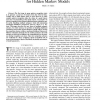63 search results - page 7 / 13 » Large Vocabulary Audio-Visual Speech Recognition Using Activ... |
ICASSP
2011
IEEE
12 years 11 months ago
2011
IEEE
Language models for speech recognition tend to be brittle across domains, since their performance is vulnerable to changes in the genre or topic of the text on which they are trai...
NIPS
2004
13 years 9 months ago
2004
In this paper, we explore the use of Random Forests (RFs) in the structured language model (SLM), which uses rich syntactic information in predicting the next word based on words ...
INTERSPEECH
2010
13 years 2 months ago
2010
In large vocabulary continuous speech recognition, decision trees are widely used to cluster triphone states. In addition to commonly used phonetically based questions, others hav...
ICASSP
2011
IEEE
12 years 11 months ago
2011
IEEE
Polish is a synthetic language with a high morpheme-perword ratio. It makes use of a high degree of inflection leading to high out-of-vocabulary (OOV) rates, and high Language Mo...
TASLP
2002
13 years 7 months ago
2002
The first stage in many pattern recognition tasks is to generate a good set of features from the observed data. Usually, only a single feature space is used. However, in some compl...



